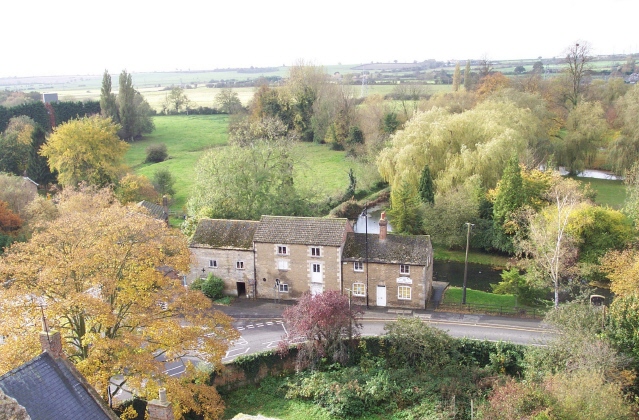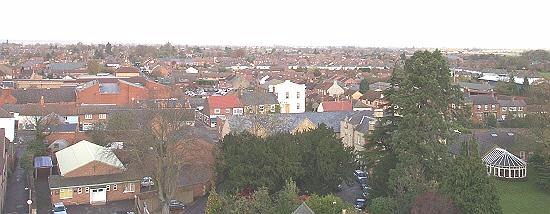|
The view from the tower
The exact height of the church tower is unknown. None of the histories that survive give a measurement and few people connected with the building can provide an answer but I can testify that it is an arduous task to climb it. David Tabor, a former churchwarden (2001-04), gives an indication and he suggests that it rises to 100 feet above ground. He bases this assumption on personal experience, his family having been associated with the building for 150 years. He told me: "There are indications at the foot of the north west pinnacle of a bench mark for 100. I was led to believe by Fred French, who was verger from some time from the end of the Second World War in 1945, that this showed it was 100 feet above ground level." The tower is accessed from inside the church by a narrow door in the north wall and beyond lies a narrow and tortuous spiral staircase of stone steps. It is dusty, cobwebbed and hazardous for the unwary but may be climbed slowly and with care, passing the belfry on the way up. On reaching the top, the only exit on to the roof of the tower is by way of a small door, little more than a trapdoor, but even this can be negotiated with care on hands and knees and then you will find yourself on the low lying battlements, the highest point in Bourne, overlooking the rooftops of this small market town and from where, on a clear day, you can spend an enjoyable few moments picking out some of the landmark buildings that define its character. I climbed the tower on Thursday 28th October 2004 with Jim Jones of the Civic Society who is also an active church member, and it was a rewarding experience. The staircase steps are in the shape of a right angled triangle, the base to the wall, and each about 10 inches high, and as there were about 120 of them, David Tabor's assumption that the tower rises to 100 feet would appear to be correct. We paused now and then to rest and ponder on those who had trod this way before, monks and church officials, usually to raise the flag on ceremonial or public occasions, or like me, motivated purely by curiosity to see the view from the top. It was most impressive. On the skyline to the north you could see the long line of terraced houses known as Woodview, built in 1898 and still providing useful accommodation, while other prominent buildings were also familiar, the vicarage and church hall, Methodist Church in Abbey Road, the Mason's Arms, the Corn Exchange, the Cedars retirement home and many more. During the Second World War of 1939-45, this was a vantage point used by the home defence organisations to keep a watch over the town, the wardens and fire watchers who climbed these steps nightly with their binoculars to scan the night sky for signs of enemy planes and there is a story that a stirrup pump, a piece of fire-fighting equipment issued during these times, could still be found here, having been abandoned when the war ended, but this has never been proven and no one has ever admitted to having seen it. The view from the tower encompasses modern Bourne, a town that is slowly spreading outwards, and although you may see its furthest edges today, the time when they have moved out of sight is not too far distant.
WRITTEN OCTOBER 2004
Go to: Main Index Villages Index
|



